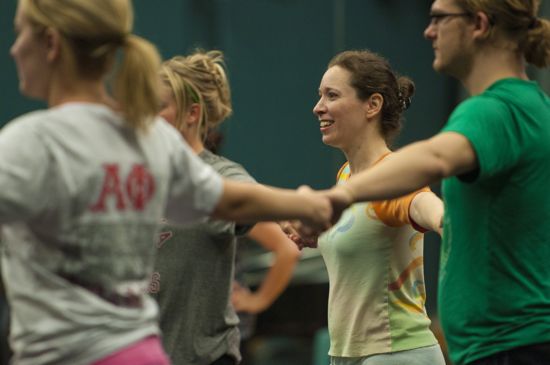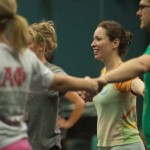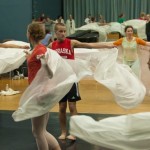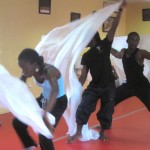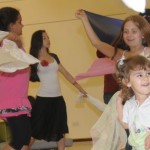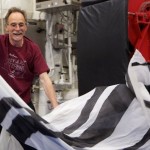MASTERCLASS
Time Lapse Dance’s “Fractal Pathways” technique, developed by Artistic Director Jody Sperling, encourages dancers to visualize energetic forces beyond their physical selves. The class begins with warm-up exercises that attune the students to their impact on the space. The dancers use micro-to-macro spatial patterning to swell subtle spiraling articulations into juicy full-body movements. They then deepen their spiral explorations into the beginnings of a whirling practice as, incrementally, they develop the skills needed for sustained spinning. Sperling then introduces fabric as a tool to help the students experience a dynamic connection of the self to the environment and discover how to soar, billow and unfold in multiple directions. “It took dance to a different level.” -student at University of Nebraska Click to READ STUDENTS’ RAVE EVALUATION OF MASTER-CLASS AT UNL
PRINCIPLES OF TIME LAPSE DANCE TECHNIQUE (EXPANDED)
Fractal Pathways
Time Lapse Dance technique focuses on energetically connecting the body, on all levels of scale, to the surrounding space. We focus on micro-to-macro spatial patterning, by gradually swelling subtle movements into juicy full-body coordinations. The emphasis is on expanding and contracting three basic spatial pathways: corkscrew spirals, figure-eights and waves. As we practice winding up and down movements, we begin overlapping articulations of the inner core and outer extremities, finding ever-shifting, dynamic arrangements of spine, fingers, hips, wrists, ribcage, ankles, toes, shins, eyes, and so on. By focusing on expanding and contracting simple forms, we allow our bodies to mimic and interact with the (unseen) atmospheric turbulence that surrounds us in every living and breathing moment.
This practice of connecting energetically to the space may lead to a path of sustained spinning, or whirling.
Whirling the Way
Stillness is an illusion. When you are standing “still,” remember the earth is orbiting the sun at approximately 67,000 mph and spinning on its own axis at about 1,000 mph at the equator. Whirling has been used as a form of prayer and meditation for the Sufi order since the 13th century. We whirl for the aesthetic joy of connecting our movement to that of the surrounding universe. When you spin for a sustained period of time, it’s possible to find a calm center from which to explore new kinetic possibilities. Whirling is a skill that must be acquired gradually to avoid dizziness or motion sickness. We introduce it incrementally in order to build tolerance for sustained rotation.
Using Fabric (a la Loie Fuller) to Visualize Space
Sperling’s interest in spatial dynamics derives in part from years of working with fabric, re-imagining the style of early modern-dance pioneer Loie Fuller (1862-1928). Fabric has the magical property of visualizing unseen energetic forces. When a body move through space it disturbs the air creating an invisible wake. A silk scarf can reveal that wake. When you work with fabric, you begin to sculpt, not just the motion of your own body, but that of the air around you. In this way, dancing with fabric helps bring a greater sensitivity to how movement literally impacts the space and affects those around you.
<<<<<<>>>>>>
A master-class in Time Lapse Dance Technique may involve elements from all three components described above.
<<<<<<>>>>>
OTHER WORKSHOPS
DANCE WATCHING & WRITING
A workshop designed for dancers or non-dancers to enhance observational skills. Movement and writing exercises are given to facilitate the ability to perceive quality and texture in performance, and to articulate more clearly what one sees. As we watch dance, we will practice asking the questions that tease out connections between action, quality and meaning. We will ask: What are the performers doing? How are they moving? And why? By engaging in a process of active looking and struggling to put what we see into words, we aim to increase our subtle understanding of the dances unfolding all around us. Ultimately, we aim to become more articulate, not just as writers, but also as movers. This workshop can be taught in one or two three-hour sessions.
TIME-LAPSE CHOREOGRAPHIC METHOD WORKSHOP
A stimulating introduction to the “time-lapse” approach to choreography. Through compositional exercises of quoting and distorting historical dance sources—provided by the instructor in the form of manuals, videos and/or photographs—this workshop frees students beyond their own imaginations and present-day assumptions about movement. The course spurs students to create their own surprising and innovative dances, with inspiration from the past. Taught as three-hour master class or available as a more intensive two-day workshop.
CHOREOGRAPHIC RESIDENCY
An intensification of the Time-Lapse Choreographic Method Workshop in which choreographer works in collaboration with the students to develop new ensemble work for performance. Two-week engagement.




